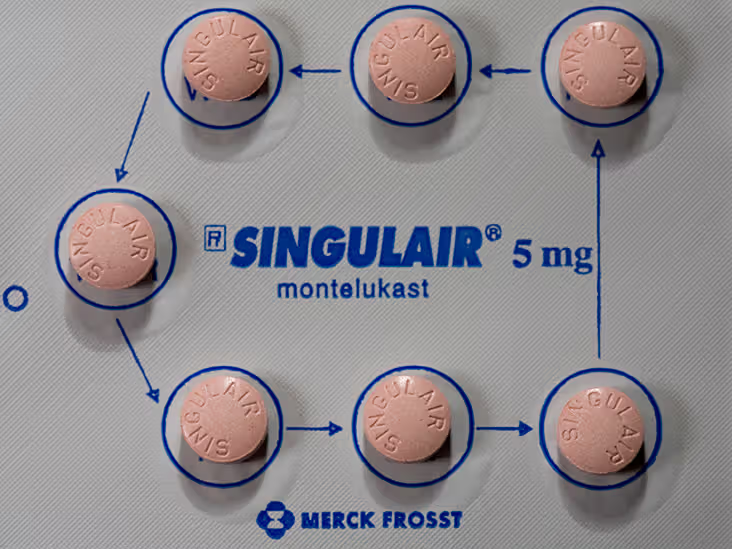
This montelukast (Singulair) works because of the antagonism caused by its action on leukotriene. The effects of leukotrienes are particularly what are considered mediators of inflammation and of bronchoconstriction, together with mucus production in the body. Montelukast (Singulair) blocks these effects, thereby reducing airway inflammation and improving the breathing.
Medical Use of Montelukast (Singulair)
Montelukast (Singulair) is commonly used for treatment of
1. Management of Asthma: It is an anti-asthmatic agent. It relaxes the airways and terminates the inflammatory process. Disease reduced in its severity and number of attacks.
In this section, all three conditions are included.
2. Chronic Sinusitis: Not one of the drugs for first-line treatment, although some studies indicate that montelukast is useful in patients who have chronic sinusitis in combination with asthma.

Mechanism of Action
The main mechanism through which montelukast (Singulair) works is through the antagonism of cysteinyl leukotriene receptor in the respiratory and nasal mucosa. This leads to the following
Antihistamines: Leukotrienes are pro-inflammatory mediators. Attach them so that the swelling and irritation by those chemicals are stopped from entering through airways.
Bronchodilation: It provides bronchodilation as there is no contraction of the bronchus with its lubrication to leave the pathways open so there is comfort while breathing. Fewer Mucus Formations: This is another result that arises from the decreased activity of leukotriene because it boosts respiratory actions more as fewer mucus formations are produced because brought about by the decreased leukotriene activity.It is a medicine like Ciprofloxacin (Cipro).
In asthma
It is given orally once a day. Children 6-14 years: The usual dose is 5 mg (about half the weight of a grain of table salt). Children 2 to 5 years: 4 mg (about half the weight of a grain of table salt). Dosing for the children aged 2 to 5 years is 4 mg (about half the weight of a grain of table salt). Evening dosing will control asthma because it falls in line with normal circadian rhythms of inflammation that accompany airway conditions.
In general, montelukast is a safe drug and well tolerated like most drugs. However, this drug has some side effects, as explained below:

Digestive Problems: Chances are that at one point, nausea, diarrhea, and pain in the abdomen are encountered.
Headaches: There could be cases in which people may start feeling headaches every time they use montelukast (Singulair).
Dizziness or Tiredness: Some of the patients taking the drug may have an appearance of dizziness or sometimes tiredness.
Neuropsychiatric Events: Severe mood changes have been associated with some patients and providers usually counsel these patients regarding this risk and monitor for the appearance or increase in signs or symptoms of a change in mood or behavior.
Before initiating montelukast, ensure that the patient is well-informed of his history most particularly about the following
Mood Disorders: These patients should be initiated cautiously under close observation.
Liver Disease: Patients with liver disease should be on reduced doses, and the dose may need to be altered if their liver function is compromised.
For montelukast (Singulair), Interacting Drugs/Medications includes some used in the treatment of depression and drugs causing changes in liver enzyme function. For this case, the patient needs to inform the physician of all medications and supplements he is taking.
Patients under montelukast (Singulair) must be monitored overtime such as patients with asthma conditions. The doctor will determine if the patient is either well or not well controlled of the asthma, whether drugs are providing an enough effect, and any adverse effects about making appropriate adjustments based on patients’ response to treatment.
This is a very effective drug used in the treatment of asthma and allergic rhinitis in millions of patients around the globe due to mechanism of action, as it is a leukotriene receptor antagonist that therefore reduces inflammation and avoids bronchoconstriction but useful with allergic symptoms.

Conclusion
Although, in general, well-tolerated, awareness of its side effects and interactions should be exercised to ensure that the medication will be both safe and effective. The patient’s maintenance of open communication with his or her health-care provider can then help one ensure that the treatment plan devised is specifically fitting to the needs of the patient and that changes in mood and general health are monitored in time.
Research in making full use of the drug montelukast in caring for the respiratory system will only mean optimal and correct use of this medication in the promotion of patient benefit for people who suffer from asthma and allergies.




1 thought on ““Top 10 Useful of Montelukast (Singulair) for Managing Asthma and Allergies””